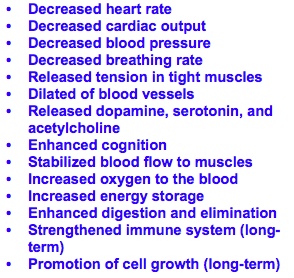Summary
Daily stress is an unavoidable part of daily life. It’s how you manage the stress that’s most important.
OnAir Post: Learning to Manage Stress
About
The Stress Response
Using Cognitive Behavior Therapy (CBT), you will learn how to relax both your mind and body.
First, let’s think about how to relax your body.
When we’re upset – the stress response automatically kicks in. The picture above depicts all the areas that are affected by this ‘sympathetic nervous’ system.
Daily stress creates wear & tear on all of us and can worsen medical illnesses. For that reason, we all need to learn to manage stress really well! We may not be able to stop stressful situations from happening … but, we can learn to manage our reaction to stress — in the moment.
The beauty of your body is that you can literally take control of your stress response (even in most stressful situations) by paying more attention to your breathing than to how stressed you feel! You can learn to turn on the ‘Relaxation Response’ with will activate your ‘Parasympathetic Nervous’ system – the opposite of the stress response.
The Relaxation Response

 The first step is to be mindful in the moment that you’re feeling stressed! The next step is to learn how to reduce your stress response …. just by using a simple breathing technique.
The first step is to be mindful in the moment that you’re feeling stressed! The next step is to learn how to reduce your stress response …. just by using a simple breathing technique.
If you breathe slowly (approximately 6.5 breathes per minute) and take a little more time on the exhale (4 seconds per inhale; 5 or 6 seconds per exhale), then you will turn on the ‘relaxation response’ (parasympathetic nervous system).
The below videos will teach and demonstrate for you exactly how to do that slow belly breathing. It takes a little practice … everyone can learn to do it in time!
How to Belly Breathe
Watch Dr. Carbonell demonstrate belly breathing
If you like apps, I recommend using the FREE Breath2Relax app … This video (which includes 4 short mini-videos) previews components of the app, which was developed by the Department of Defense.
Techniques (if your brain is too ‘busy’ to relax)
There are two science-based techniques that work really well, especially if you feel too antsy to just do the breathing:
Progressive Muscle Relaxation
Visual Imagery
Progressive Muscle Relaxation (PMR)
Below are two guided practices. The first is shorter, has a male voice, and shows you the muscle groups. The second is longer, has a female voice, calm music in the background. Get a sense of the kind of guide you prefer. Finally, take some time to make it your own exercise. Pick from a wide variety – now that you know what the basic elements are:
Systematically switch from muscle tensing to relaxing
Notice the deeper relaxation in each area by way of contrast from tension
Rhythmically simplify instructions
Notice the deeper relaxation upon exhaling – the exhale turns ON the relaxation response!
Shorter version (6 minutes)
Longer version (15 minutes)
Visual Imagery (a misnomer!)
Below are two guided practices: (1) a beach scene, and (2) a woods scene. It doesn’t matter where you take yourself (think of it like a mini-vacation in your mind). In fact, some people prefer sheer magical fantasy, like being in a Disneyland of their own.
It’s a misnomer because the important thing is to pay attention to using ALL your senses: see the sights, as you hear the sounds, as you touch the textures, as you smell the fragrances, as you savor the tastes. The goal is to be IN the experience … rather than just see it. Fill it with your own personalized memories of pleasant feelings and smells and bring in anything that is calming to you, like a special warm loving hug.
Take some time to find your own preferred imagery … with some ideas from this variety of imagery videos.
Beach
https://www.youtube.com/watch?v=ar_W4jSzOlM
Woods
Brief Grounding (calming) Techniques
Sometimes we feel way too keyed up to even begin a relaxation session (breathing, PMR, or visual imagery). Whenever you feel overly stressed (over a ‘5’ out of ’10’), it’s a good idea to try one of several very brief behavioral techniques to bring yourself to a calmer state. They’re called ‘grounding’ techniques because they’re simply meant to get you more in touch with feeling safe and secure – in the ‘here & now’ rather than thinking about the past or worrying about the future.
I recommend trying several, to find one that can become your go-to quick rescue. These videos explain how to use your senses to get grounded right away, how to create your own safe place, how to count your breaths, and even how to use yawning to access a calmer state.
Best of all worlds, you will practice doing one of these daily so that you will be skillful … whenever you really need to pull this ‘relaxation’ skill out of your mental health toolkit – on your demand to calm yourself.
Calming Yourself (fast) from High Stress
Yes, there’s a proven technique to manage high stress fast. Dr. Ali Mattu explains/demonstrates this in his video. You can achieve the same response by putting a frozen washcloth on your forehead.
NOTE: Don’t try this without consulting your physician first – especially if you have any type of heart disease!
Well-Being is a Skill
Modern neuroscience teaches that we can train our brains to have more well-being; it’s a skill to learn. Watch a thought-leader in the field of neuropsychology, Dr. Davidson, talk in Part I … about the science of well-being and in Part II … the 4 constituents of well-being, including the importance of practicing mindfulness.

